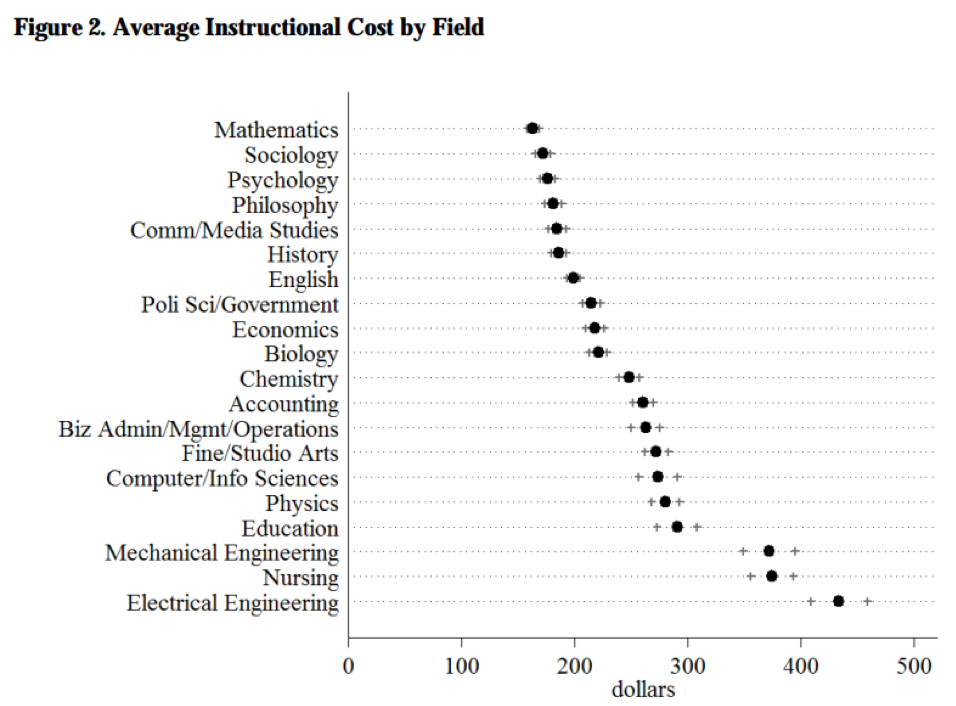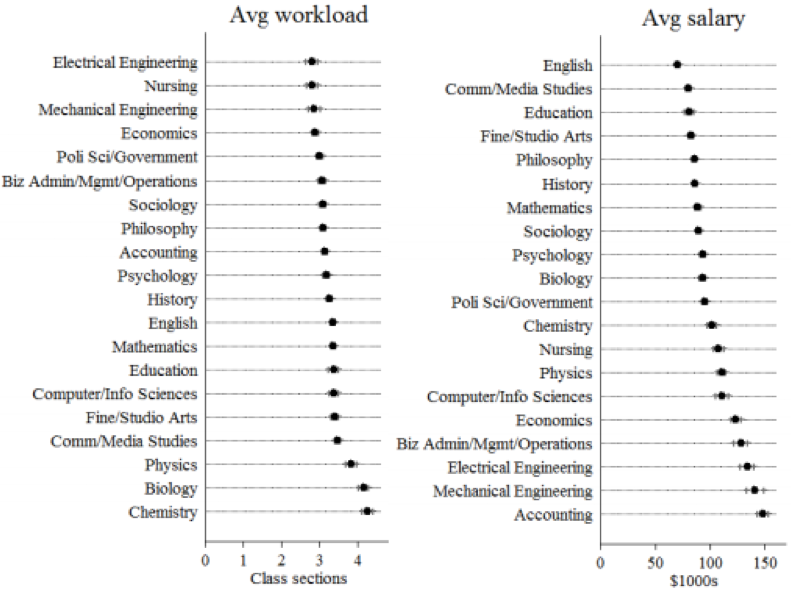Written by
on

How much does it cost to deliver a course? Do costs vary between programs? What accounts for the difference? What decisions can we make with this information?
These are some of the questions explored in a recent paper published by the National Bureau of Economic Research titled, “Why is Math Cheaper than English? Understanding Cost Differences in Higher Education.”
The authors analyzed what it costs to deliver education in 20 academic fields ranging from fine arts to electrical engineering. They compiled data from a variety of public and private institutions and examined the costs to deliver each program.
If you or your colleagues are asking any of the questions listed above (and a lot of people are), take a moment to read the full study. But your time is precious and, at the end of the day, it’s still an academic paper so it’s not exactly a beach read. With that in mind, I’ve summarized the key findings of the paper, my observations from doing similar research myself, and implications to think about for your institution. If you’re interested in learning more about market research, explore our research solutions.
This blog post is a bit different from our other writings, but I hope you enjoy the takeaways I’ve distilled and consider their implications for your own situation.
Four key takeaways from the study:
- Over the past 15 years, average instructional costs have stayed relatively flat. However, the overall picture obscures the variation between programs (see chart below).
- Costs vary widely between fields. The average cost to deliver a program is $222 per credit hour, but electrical engineering topped the list at $475/credit hour and math was at the bottom at less than $175/credit hour.
- Increases in class size and teaching loads explain declines in costs along with a general shift toward lower-cost faculty (adjunct appointments and teaching assistants as opposed to tenure-track professors).
- Online instruction leads to a modest reduction in costs but only for undergraduate programs.

In addition to the key takeaways, there are several highlights from the findings worth reviewing:
- Economics, business, accounting, and political science generally have higher faculty salary costs, but these costs are offset by larger class sizes.
- Engineering and nursing are more expensive due to higher faculty salaries and lower teaching loads (fewer sections per term) without larger classes to offset the cost.
- The natural sciences—such as biology, chemistry, and physics—generally have higher non-personnel expenses for things like lab materials, but these higher costs are offset by high teaching loads (due to lab sections).

- Programs vary widely in the percentage of professors who are on the tenure track.
- Nursing has the lowest share of tenure-track professors (due, in part, to the challenge of finding full-time nursing faculty).
- STEM fields have the highest shares of professors on the tenure track.
- Class type—lower division undergraduate, upper division undergraduate, and graduate—also affects program costs, and class types vary between programs. Lower-division courses are less costly because they tend to have larger class sizes and because they are more likely to be taught by lower-cost faculty such as TAs and lecturers.
- Biology, chemistry, and physics tend to offer a lot of lower-division courses.
- Professional programs such as accounting, mechanical engineering, and nursing tend to have more upper-division undergraduate and graduate courses.
- Merely offering a few online courses does not lower a program’s costs, but a program that offers a substantial number of online courses will lower costs.
- A fully online program is 29 percent less expensive to offer than an in-person program.
- There is less evidence to suggest that this is true for graduate programs, which is noteworthy because so many graduate programs are available online.
Two key implications of these findings:
- Differential pricing for academic programs: Differential pricing has become more prevalent in recent years as colleges (logically) charge higher tuition for higher-cost and higher-earning fields. When colleges offer differential pricing, students in programs such as nursing, engineering, and business pay higher tuition than their peers in the humanities or social sciences. This analysis would seem to support differential pricing for programs that cost more for institutions to deliver. However, in my view, the stronger argument for colleges is to focus on value and return on investment. Programs that produce graduates who are in high demand with high average salaries can justifiably charge more because the value for the student is greater.
- Potential effects of lowering costs: The research is clear: Colleges can reduce the cost of delivering academic programs by increasing class sizes, requiring professors to teach more sections, using non-tenure-track faculty, and limiting non-personnel expenses such as lab equipment. Granted, many within the higher education community will find these “solutions” cringeworthy. It is therefore critical for colleges to be aware of what impact these measures have on the quality of the academic experience (and subsequently, how that influences the college’s reputation). No cost-saving attempt exists in isolation. Because universities operate within a dynamic system, every decision carries multiple ramifications. Colleges concerned about cost should take a holistic view of expense management and consider the effects on academic quality.
One final thought: The researchers do an excellent job of analyzing the costs of delivering academic programs, but no consideration is given to the revenue side of the equation. (In all fairness, revenue was outside the scope of the research). It is important to consider both because, just like costs, revenues can vary between academic programs. Consider two examples we’ve seen in our work:
The first is a university that awards scholarships to student-athletes. Therefore, the net tuition revenue for student athletes is, on average, lower than for other students. We’ve seen in the past that student-athletes tend to enroll in majors related to athletics such as sports management or exercise science. If that’s the case, then the net revenue for these programs is going to be lower than for other fields.
The second is an institution that offers a finance program. Students who enroll in finance programs often have parents who work in the financial sector (for some reason, this field seems to be “hereditary”). Since finance is often a lucrative field, the children of those who work in finance are less likely to receive need-based financial aid. Therefore, the net tuition revenue from students who enroll in finance programs may be higher than the average net tuition revenue for students in other programs.
Both scenarios illustrate why tuition revenue should be considered in any financial analysis of academic programs. Furthermore, a program’s revenue can come from other sources such as research grants or licensed products.
Clearly, there are a lot of things to take into account when analyzing the “profitability” of academic programs. And more colleges are likely to conduct this analysis as institutions continue to grapple with the economics of higher education. For those considering the types of questions listed at the beginning of this article, this research is an excellent resource for understanding program costs.
One takeaway is clear: It’s not only important to have the right data, it’s crucial to understand the potential implications of acting on that data. Increase your institution’s revenue and reduce overhead with research.
Learn more about Stamats’ Customized Research Services.
Ready to Get Started?
Reach out to us to talk about your strategy and goals.


